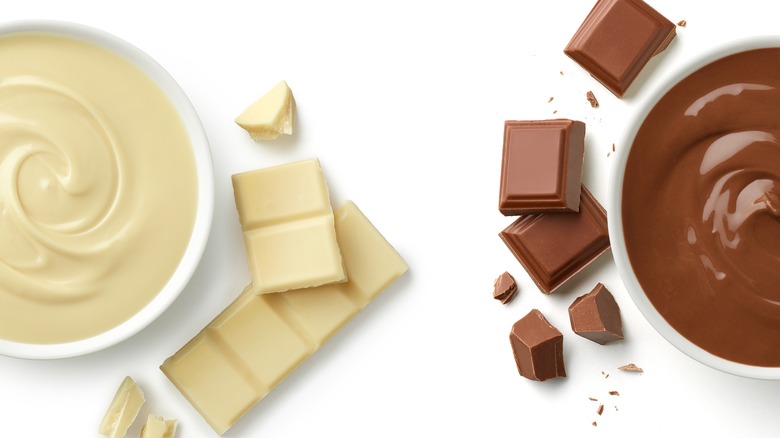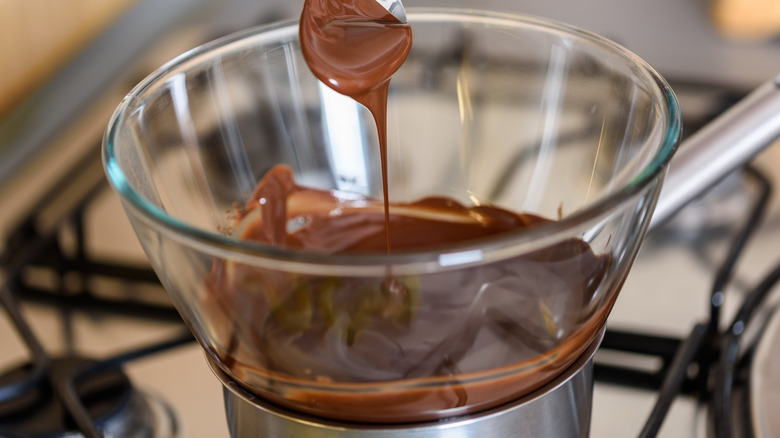The Temperature Your Chocolate Cannot Be Heated Beyond
Chocolate is a rich and creamy delicacy that's beloved by almost everyone. MasterClass shares that with eight different types of chocolates and three main types of chocolates, including dark chocolate, milk chocolate, and white chocolate, you're bound to find one that satisfies your sweet tooth.
Grabbing a chocolate bar from the grocery store is easy. But when it comes time to work with chocolate in the kitchen, it can be quite tricky. For example, if you've ever made a chocolate-covered strawberry recipe, you've probably run into the issue of overheating your chocolate, resulting in a thick, muddy texture.
If you struggle with overheating your chocolate while baking, get ready to learn about the magic temperature it can't be heated beyond, along with some tips and tricks to keep in mind when working with chocolate. Your desserts will soon be covered in the smoothest, velvety chocolate you could ever dream of.
What temperature should your chocolate never exceed?
There are three main types of chocolates: dark chocolate, milk chocolate, and white chocolate. Each is delicious in their own way and requires different melting points. According to The Royal Society of Chemistry, chocolate is made from the beans inside the seed pods of cocoa trees, with beans comprising roughly 50% cocoa butter. However, depending on the ratio of fatty cocoa butter used, the melting range of chocolate can vary. The fats in cocoa butter form six different types of crystals through a process called tempering. Chocolatiers try to achieve Type V crystallization (92.84 F), which is best for eating because it gives chocolate bars a crispy snap and melts near body temperature.
That said, dark chocolate is made up of 85% cocoa solids and begins melting around 114.8 F. Milk chocolate is made up of 20-50% cocoa solids and begins melting between 104 and 113 F. And last but not least, white chocolate, which has no cocoa solids and around 20% cocoa butter, melts between 98.6 and 109.4 F.
Because you're not a chocolatier and are most likely melting chocolate for treats such as truffles, cookies, fruit, pretzels, and marshmallows, what is the average temperature you should strive for when melting chocolate? Joan Giachetti, chief chocolate maker at Le Bristol Paris, told Food & Wine that chocolate should never be heated beyond 133 F.
More chocolate melting tips
Now that you know the magic number for melting chocolate — 133 F — what are some other chocolate melting tips? And what's the best method for melting chocolate?
Ree Drummond says the best way to melt chocolate is by using a double boiler, which is essentially a heat-proof bowl placed on top of a saucepan of bubbling water. The steam from the water softens the chocolate slowly, allowing you to control the chocolate's melting point better. However, you'll want to ensure the water doesn't touch the bowl of chocolate, as this could heat the chocolate too quickly and ruin the desired consistency.
If you're planning on melting your chocolate in the microwave, Drummond suggests heating it in 30-second intervals and stirring in between. She also suggests using your microwave at only 50% power to avoid scorching the chocolate. For added assurance, you can add one teaspoon of coconut oil to your chocolate before melting to help give it a lusciously smooth and glossy finish, adds Southern Living.


